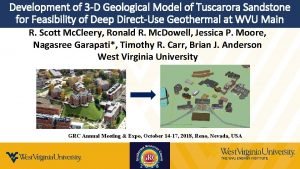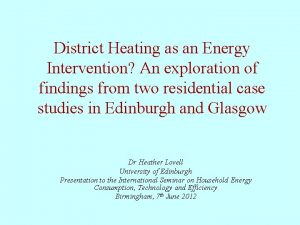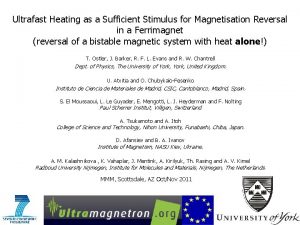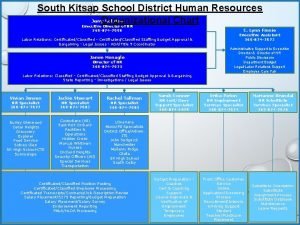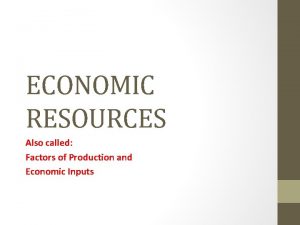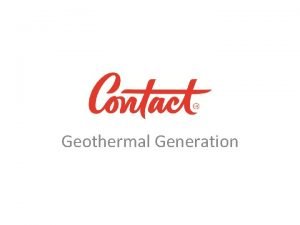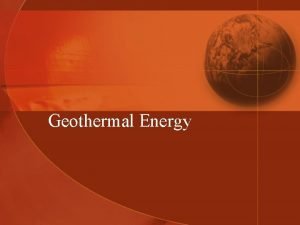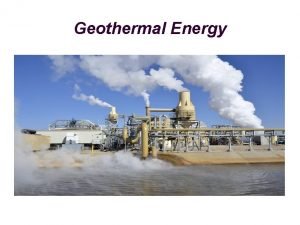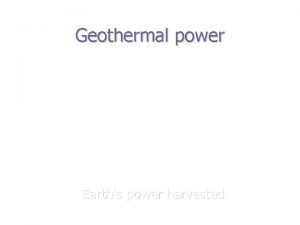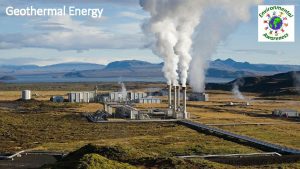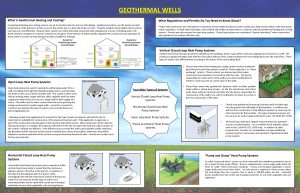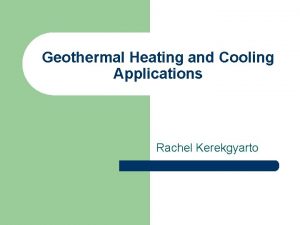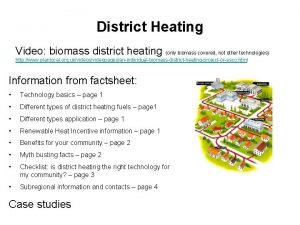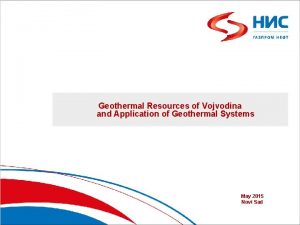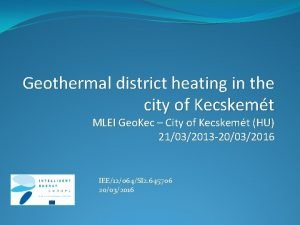LowTemperature Geothermal Resources for District Heating An Economic










![Population Density Factor • [1]: C. Augustine, “Hydrothermal spallation drilling and advanced energy conversion Population Density Factor • [1]: C. Augustine, “Hydrothermal spallation drilling and advanced energy conversion](https://slidetodoc.com/presentation_image_h2/c58860d1905c5f579f314c803f63102e/image-11.jpg)





- Slides: 16

Low-Temperature Geothermal Resources for District Heating An Economic Analysis of Geothermal District Heating System by Using Arc. GIS Xiaoning He 1, Brian J. Anderson 1 Department of Chemical Engineering, West Virginia University Morgantown, WV, 26506, USA Email: brian. anderson@mail. wvu. edu Department of Chemical Engineering

Outline • • 2 Introduction Modeling Approach Result and Discussion Acknowledgements Department of Chemical Engineering

Introduction • Geothermal energy: stable, environmentally-friendly, renewable, baseload energy supply. • 20% of total energy is used for such low temperature end-use – geothermal energy can satisfy this end-use. 70% of whcih for heating and AC 30% of which for heating Figure 1: US Energy consumption scenario[EIA, 201 “Energy consumption estimates by sector, 1949 -2010, ” U. S. EIA, 2011 3 Department of Chemical Engineering

Introduction • Geothermal District Heating System (GDHS) Basics – Injection well and production well – Surface heat exchanger system –Distribution network Pipeline Figure 2: Two-well Geothermal System Schema “The Future of Geothermal Energy”, MIT, 2006 Buildings 4 Figure 3: Distribution Network Schematic [NREL, 2004] “H 2 A Scenarios for Delivering Hydrogen , ” NREL, 2004 Figure 4: Heat Exchanger Schema Department of Chemical Engineering

Modeling Approach • 5 Include wells’ drilling, surface equipment investment, pipeline network cost, O&M cost, etc. Department of Chemical Engineering

Geothermal Gradient Factor • Data Analysis Original Data with depth, temperature, longitude, latitude Add into Arc. Map Create temperature maps at each depth Python Coding for each map Data interpolation by IDW to create temperature surface for each map Get mean temperature at each census tract by zonal statistics as tables Calculate gradient for each census tract Figure 5: Data Analysis Procedure 6 Department of Chemical Engineering

Geothermal Gradient Factor • Data Analysis Results °C/km °C Figure 6: Geothermal Temperature at Depth at 3. 5 km to 8. 5 km Figure 7: Geothermal Gradient M 7 Department of Chemical Engineering

Geothermal Gradient Factor • Preliminary Work: WVU Case Study – – – Location: WVU Evansdale campus Geothermal gradient: 26. 44°C/km Population: 30, 000 students Heating in winter and cooling in summer Distribution network: current steam pipeline Levelized cost of geothermal energy: $5. 30/MMBtu • Geothermal Gradient Influence – By changing the 8 gradient of the case study, and keeping all the other factors constant, get and plot the levelized cost vs. gradient. Department of Chemical Engineering

Population Density Factor Q=m. CpΔT Energy Consumptio n Estimation Distribution Network Cost Surface Plant Cost Levelize d Cost 9 Department of Chemical Engineering

Average Household Usage: 220 MMBtu/year Average Household Size: 2. 5 people Low-temperature End -use fraction: 0. 68 Household Number: base on WV census tract Distribution Network Estimation Energy Consumption Estimation Population Density Factor Electricity cost for pumping: $0. 08/k. Wh Pipe sizing: base on mass flow rate [1]: C. Yang, J. Ogden, “Determining the lowest-cost hydrogen delivery mode”, Institute of Transportation Studies, University of California, Davis, 2006 10 Department of Chemical Engineering
![Population Density Factor 1 C Augustine Hydrothermal spallation drilling and advanced energy conversion Population Density Factor • [1]: C. Augustine, “Hydrothermal spallation drilling and advanced energy conversion](https://slidetodoc.com/presentation_image_h2/c58860d1905c5f579f314c803f63102e/image-11.jpg)
Population Density Factor • [1]: C. Augustine, “Hydrothermal spallation drilling and advanced energy conversion technology for enginee Department of Chemical Engineering, Massachusetts Institution of Technology, 2003 [2]: S. K. Sanyal, “Cost of geothermal power and factors that affect it, ” Stanford Geothermal Workshop, 200 11 Department of Chemical Engineering

Result and Discussion • With the constant population density, the levelized cost decreases with the increase of geothermal gradient. • With the constant geothermal gradient, levelized cost decreases with the increase of population density. Levelized Cost($/MMBtu) Levelized Cost Function of Geothermal Gradient at Pop-density of 2100 ppl/km 2 Levelized Cost ($/MMBtu) 30 13, 3 25 13, 1 12, 9 20 12, 7 15 12, 5 10 12, 3 12, 1 5 11, 9 13 14 15 16 17 18 19 20 21 22 23 24 25 26 27 28 Geothermal Gradient (°C/km) 12 Levelized Cost Function of Population Density at Geo-gradient of 25. 71 °C/km 0 0 5000 10000 15000 20000 25000 30000 Population Density (ppl/km 2) 35000 Department of Chemical Engineering

Result and Discussion 13 Figure 8: 3 D levelized cost function Department of Chemical Engineering

WVU Case Coal Plant Natural Gas Solar Figure 9: Levelized Cost Map of West Virginia 14 Department of Chemical Engineering

Result and Discussion • To be improved: – Distribution network: estimation of pipeline length is rough. Want to check if Arc. Map can be used to develop a distribution network model. – The geothermal gradient is based on the average temperature of each census tract. This makes the geothermal gradient smaller than reality. – Try to find other maps with only middle or big cities, rather than the census tract map. This will save time when doing this model nationwide. 15 Department of Chemical Engineering

Acknowledgements • Project partners: – Mr. M. G. Bedre and Mr. J. Peluchette • G & G department: – Dr. J. Conley, Dr. G. Elmes and Dr. K. Kuhn • Lab workers: – Ms. N. Garapati, Mr. M. Gaddipati, Mr. S. Velaga • Department of Energy’s Geothermal Technologies Program, Project EE 0002745 for funding 16 Department of Chemical Engineering
 Geothermal cooling tuscarora
Geothermal cooling tuscarora Southampton district energy scheme
Southampton district energy scheme Difference between induction heating and dielectric heating
Difference between induction heating and dielectric heating Wyndford estate glasgow district heating
Wyndford estate glasgow district heating Jgd district heating
Jgd district heating Ken brady
Ken brady Termis district heating software
Termis district heating software Kyrene school district employment
Kyrene school district employment Laredo independent school district human resources
Laredo independent school district human resources South kitsap school district human resources
South kitsap school district human resources Renewable resources vs nonrenewable resources
Renewable resources vs nonrenewable resources Transformation process
Transformation process Example of fixed resources
Example of fixed resources Economic resources
Economic resources Chapter 2 economic resources and systems
Chapter 2 economic resources and systems Economic resources are also called:
Economic resources are also called: Economic growth and development
Economic growth and development
